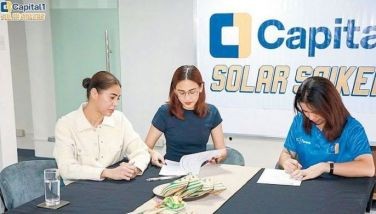Take two on E2E
January 26, 2004 | 12:00am
In a recent "guruing" session, two friends shared their transition from employment to entrepreneurship or from employee to employer. This is another version of what we have termed in last week’s column as E2E. Both persons are relatively successful in their chosen professional fields. One is a medical doctor in the field of orthopedic surgery who has chalked up 10 years of successful practice. The other is a professional who served as operations manager in a logistics firm.
The transition we are talking about has a cash flow impact. An employee is certain of cash inflow every seven to 15 days since it is implicit in the employer-employee relation that this is to be paid regularly no matter what happens. An entrepreneur’s cash flow is irregular. It can be hourly, daily, weekly, monthly, quarterly, semi-annually, annually or a mix of all of the above. What is certain is the uncertainty of cash inflow.
What makes this transition difficult for many is the fact that the cash outflow is certain, that is, for food, shelter, and education for the family members. Thus, the uncertain inflow of cash coupled with certain outflow of cash is indeed a scary combination.
However, if the transition from E2E is made successfully, this will result into uncertain cash inflows whose grand total is many times over the certain cash outflow. It should also be noted that the certain cash inflows of his/her employees are part of the cash outflow of the entrepreneur.
While this is an intimidating thought, we can learn from the "guruing" session with these two transitioning individuals.
• Why the bold move?
The first question raised was: Given the uncertainties, why did you even consider the transition? You do not exactly have meager incomes.
The doctor’s reply was straightforward. As a surgeon, his ability to continuously earn is a function of both his cerebral capability and his manual dexterity. The time will come when his hands would no longer be able to perform what his brain would generate. He had been struck by the comments of a patient who happened to be an entrepreneur: "When I’m sick, my enterprise still earns money for me to pay for my medical expenses but, when you get sick, do you still earn?"
This sudden realization prompted the doctor to think about his options. He could work hard while his hands were capable and generate savings that could fund the cash outflow when the inflow declines. Alternatively, he could set up an enterprise that would outlive the usefulness of his hands and maintain a cash inflow on a long-term basis.
The professional manager responded differently. He realized that the ceiling of the cash inflow would be higher as an entrepreneur. He wanted to shore up more funds to finance his desired quality of family life.
In both cases, the objective was to have a better and sustainable source of cash inflow. In both cases, the reference was also the person and his circumstance.
Based on their rationalizations, the generic answer to the first question follows, that is, the desire to migrate from an employee/professional to an entrepreneur is driven by a desire to have a better and economically sustainable life. Clearly, the desire or passion must be there. Likewise, the link of the enterprise to be set up to the individual’s personal vision, mission, and objective must be clear.
• Why this particular nature of enterprise?
In both cases, the two recognized and accepted that there was great risk involved in the transition. The risk of losing proven regular cash inflow because of the practice of a professional or employment is very real. But this realization was also the very key to their answer to the question: Why this particular nature of enterprise?
The medical doctor, after 10 years of practice, understood the psychological pain a patient undergoes. He asked critical questions like: Why does a clinic have to look like a place for the sick? Can’t a doctor’s equipment look less antiseptic? Why can’t a visit to the doctor or dentist be fun? How often have we heard children refuse to visit a doctor or dentist because they have labeled the clinic as a place of pain and bad memories? He knew how patients could get traumatized when seeking healthcare services.
Proceeding along this line of questioning, the next question hit the bull’s eye: So, why not make the doctor/dentist experience fun for patients? His entrepreneurial venture focused on products and services that would do just that, that is, turn a doctor/dentist visit into a delightful encounter. After conducting entrepreneurial research and development, there are now fun medical products in the market and a service to design hospital rooms and clinics.
This doctor chose a nature of the enterprise that he was familiar with, that was related to his current profession. Most important, he was passionate about doing something about it.
The professional manager put up two trading/retail shops that sold phone cards, internet pre-paid cards, and other related products. However, these outlets do not have any repair service. He chose this nature of the enterprise because it was easy to monitor and manage. Adding a service operation would only make the business model complicated and harder to manage. In fact, he was not really fond of the products of the enterprise; it was just easy to get it started.
When asked about the location of the two stores, his answer is a good practical lesson to others contemplating E2E. One store is near his home. The other is near his office. He could check on the enterprise easily because of their proximity to both venues of his work/home life.
Rightfully, the tip is to choose a nature of enterprise that can be near you to facilitate the transition. Nearness can be also defined as near to home or the office.
• How did you start?
The transition in these two examples was not done cold turkey.
Even at this time, both are works in progress. One of them is already having a cash flow from the entrepreneurial activity that is larger than the income derived from being a professional. The important message, therefore, is to start the enterprise while employed but choose a business that is near or convenient. A start-up that uses the near strategy will make the risks less and the transition easier.
And, since the two are still in transition, the last question could be: When does one become a full-time entrepreneur? To which the simple answer may be: When the cash flow becomes regular and predictable just like one’s income from employment but is predicted to increase in a geometric manner, not like the salary of a mere hired hand.
(Alejandrino Ferreria is the dean of the Asian Center for Entrepreneurship of the Asian Institute of Management. For further comments and inquiries, you may contact him at: [email protected]. Published "Entrepreneur’s Helpline" columns can be viewed on the AIM website at http//: www.aim.edu.ph).
The transition we are talking about has a cash flow impact. An employee is certain of cash inflow every seven to 15 days since it is implicit in the employer-employee relation that this is to be paid regularly no matter what happens. An entrepreneur’s cash flow is irregular. It can be hourly, daily, weekly, monthly, quarterly, semi-annually, annually or a mix of all of the above. What is certain is the uncertainty of cash inflow.
What makes this transition difficult for many is the fact that the cash outflow is certain, that is, for food, shelter, and education for the family members. Thus, the uncertain inflow of cash coupled with certain outflow of cash is indeed a scary combination.
However, if the transition from E2E is made successfully, this will result into uncertain cash inflows whose grand total is many times over the certain cash outflow. It should also be noted that the certain cash inflows of his/her employees are part of the cash outflow of the entrepreneur.
While this is an intimidating thought, we can learn from the "guruing" session with these two transitioning individuals.
• Why the bold move?
The first question raised was: Given the uncertainties, why did you even consider the transition? You do not exactly have meager incomes.
The doctor’s reply was straightforward. As a surgeon, his ability to continuously earn is a function of both his cerebral capability and his manual dexterity. The time will come when his hands would no longer be able to perform what his brain would generate. He had been struck by the comments of a patient who happened to be an entrepreneur: "When I’m sick, my enterprise still earns money for me to pay for my medical expenses but, when you get sick, do you still earn?"
This sudden realization prompted the doctor to think about his options. He could work hard while his hands were capable and generate savings that could fund the cash outflow when the inflow declines. Alternatively, he could set up an enterprise that would outlive the usefulness of his hands and maintain a cash inflow on a long-term basis.
The professional manager responded differently. He realized that the ceiling of the cash inflow would be higher as an entrepreneur. He wanted to shore up more funds to finance his desired quality of family life.
In both cases, the objective was to have a better and sustainable source of cash inflow. In both cases, the reference was also the person and his circumstance.
Based on their rationalizations, the generic answer to the first question follows, that is, the desire to migrate from an employee/professional to an entrepreneur is driven by a desire to have a better and economically sustainable life. Clearly, the desire or passion must be there. Likewise, the link of the enterprise to be set up to the individual’s personal vision, mission, and objective must be clear.
• Why this particular nature of enterprise?
In both cases, the two recognized and accepted that there was great risk involved in the transition. The risk of losing proven regular cash inflow because of the practice of a professional or employment is very real. But this realization was also the very key to their answer to the question: Why this particular nature of enterprise?
The medical doctor, after 10 years of practice, understood the psychological pain a patient undergoes. He asked critical questions like: Why does a clinic have to look like a place for the sick? Can’t a doctor’s equipment look less antiseptic? Why can’t a visit to the doctor or dentist be fun? How often have we heard children refuse to visit a doctor or dentist because they have labeled the clinic as a place of pain and bad memories? He knew how patients could get traumatized when seeking healthcare services.
Proceeding along this line of questioning, the next question hit the bull’s eye: So, why not make the doctor/dentist experience fun for patients? His entrepreneurial venture focused on products and services that would do just that, that is, turn a doctor/dentist visit into a delightful encounter. After conducting entrepreneurial research and development, there are now fun medical products in the market and a service to design hospital rooms and clinics.
This doctor chose a nature of the enterprise that he was familiar with, that was related to his current profession. Most important, he was passionate about doing something about it.
The professional manager put up two trading/retail shops that sold phone cards, internet pre-paid cards, and other related products. However, these outlets do not have any repair service. He chose this nature of the enterprise because it was easy to monitor and manage. Adding a service operation would only make the business model complicated and harder to manage. In fact, he was not really fond of the products of the enterprise; it was just easy to get it started.
When asked about the location of the two stores, his answer is a good practical lesson to others contemplating E2E. One store is near his home. The other is near his office. He could check on the enterprise easily because of their proximity to both venues of his work/home life.
Rightfully, the tip is to choose a nature of enterprise that can be near you to facilitate the transition. Nearness can be also defined as near to home or the office.
• How did you start?
The transition in these two examples was not done cold turkey.
Even at this time, both are works in progress. One of them is already having a cash flow from the entrepreneurial activity that is larger than the income derived from being a professional. The important message, therefore, is to start the enterprise while employed but choose a business that is near or convenient. A start-up that uses the near strategy will make the risks less and the transition easier.
And, since the two are still in transition, the last question could be: When does one become a full-time entrepreneur? To which the simple answer may be: When the cash flow becomes regular and predictable just like one’s income from employment but is predicted to increase in a geometric manner, not like the salary of a mere hired hand.
(Alejandrino Ferreria is the dean of the Asian Center for Entrepreneurship of the Asian Institute of Management. For further comments and inquiries, you may contact him at: [email protected]. Published "Entrepreneur’s Helpline" columns can be viewed on the AIM website at http//: www.aim.edu.ph).
BrandSpace Articles
<
>
- Latest
Latest
Latest
January 2, 2025 - 2:00pm
January 2, 2025 - 2:00pm
December 17, 2024 - 12:00am
December 17, 2024 - 12:00am
December 16, 2024 - 10:00am
December 16, 2024 - 10:00am
December 5, 2024 - 12:00am
December 5, 2024 - 12:00am
Recommended






























